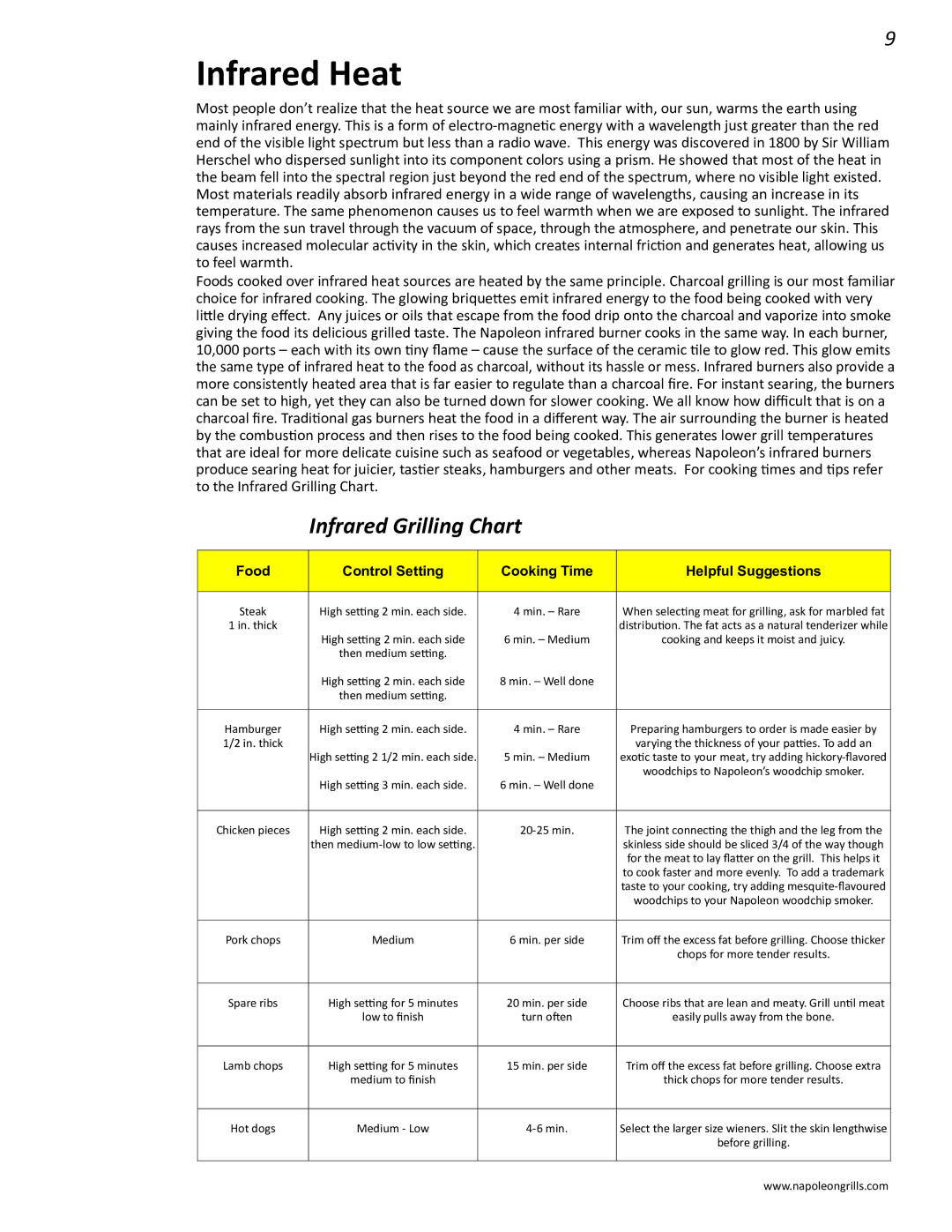
9
Infrared Heat
Most people don’t realize that the heat source we are most familiar with, our sun, warms the earth using mainly infrared energy. This is a form of
Foods cooked over infrared heat sources are heated by the same principle. Charcoal grilling is our most familiar choice for infrared cooking. The glowing briquettes emit infrared energy to the food being cooked with very little drying effect. Any juices or oils that escape from the food drip onto the charcoal and vaporize into smoke giving the food its delicious grilled taste. The Napoleon infrared burner cooks in the same way. In each burner, 10,000 ports – each with its own tiny flame – cause the surface of the ceramic tile to glow red. This glow emits the same type of infrared heat to the food as charcoal, without its hassle or mess. Infrared burners also provide a more consistently heated area that is far easier to regulate than a charcoal fire. For instant searing, the burners can be set to high, yet they can also be turned down for slower cooking. We all know how difficult that is on a charcoal fire. Traditional gas burners heat the food in a different way. The air surrounding the burner is heated by the combustion process and then rises to the food being cooked. This generates lower grill temperatures that are ideal for more delicate cuisine such as seafood or vegetables, whereas Napoleon’s infrared burners produce searing heat for juicier, tastier steaks, hamburgers and other meats. For cooking times and tips refer to the Infrared Grilling Chart.
Infrared Grilling Chart
Food | Control Setting | Cooking Time | Helpful Suggestions |
|
|
|
|
Steak | High setting 2 min. each side. | 4 min. – Rare | When selecting meat for grilling, ask for marbled fat |
1 in. thick |
|
| distribution. The fat acts as a natural tenderizer while |
| High setting 2 min. each side | 6 min. – Medium | cooking and keeps it moist and juicy. |
| then medium setting. |
|
|
| High setting 2 min. each side | 8 min. – Well done |
|
| then medium setting. |
|
|
|
|
|
|
Hamburger | High setting 2 min. each side. | 4 min. – Rare | Preparing hamburgers to order is made easier by |
1/2 in. thick |
|
| varying the thickness of your patties. To add an |
| High setting 2 1/2 min. each side. | 5 min. – Medium | exotic taste to your meat, try adding |
| High setting 3 min. each side. | 6 min. – Well done | woodchips to Napoleon’s woodchip smoker. |
|
| ||
|
|
|
|
Chicken pieces | High setting 2 min. each side. | The joint connecting the thigh and the leg from the | |
| then |
| skinless side should be sliced 3/4 of the way though |
|
|
| for the meat to lay flatter on the grill. This helps it |
|
|
| to cook faster and more evenly. To add a trademark |
|
|
| taste to your cooking, try adding |
|
|
| woodchips to your Napoleon woodchip smoker. |
|
|
|
|
Pork chops | Medium | 6 min. per side | Trim off the excess fat before grilling. Choose thicker |
|
|
| chops for more tender results. |
|
|
|
|
Spare ribs | High setting for 5 minutes | 20 min. per side | Choose ribs that are lean and meaty. Grill until meat |
| low to finish | turn often | easily pulls away from the bone. |
|
|
|
|
Lamb chops | High setting for 5 minutes | 15 min. per side | Trim off the excess fat before grilling. Choose extra |
| medium to finish |
| thick chops for more tender results. |
|
|
|
|
Hot dogs | Medium - Low | Select the larger size wieners. Slit the skin lengthwise | |
|
|
| before grilling. |
|
|
|
|
www.napoleongrills.com
